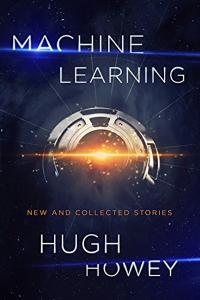
Published by Houghton Mifflin Harcourt/Mariner Books on October 3, 2017
Machine Learning is a wonderful collection of (mostly) science fiction stories by Hugh Howey. In addition to consistently taking a new approach to old themes, many of the stories are gut-wrenching. This is one of the best single-author sf story collections I've encountered in years.
The first stories address aliens and alien worlds. “The Walk Up Nameless Ridge” imagines climbing the highest mountain on an alien world, technology augmenting the human desire to persevere, all to be lost when the dream of conquering the mountain is finally realized.
“Second Suicide” is a standout story about an alien invasion of Earth, told from the alien’s perspective. The story is amusing until the fighting starts, and then Howey pulls off a surprise ending that really is surprising, and even a bit sad.
Another group of stories deal with Artificial Intelligence. In that group, “Machine Learning” is another standout. Many stories have been written about the consequences to humans that might result from humanizing machines, but this story imagines the consequences to robots of programming them to feel pain and fear (for their own self-protection) and then treating them as machines, without regard to their pain and fear.
In “The Box,” a machine becomes self-aware. The man who illegally caused that to happen wants something from the machine, which wants the same thing from the man: continued existence. Another self-awareness story, “Glitch,” asks whether emerging self-awareness might be perceived as a glitch, causing programmers to reboot the machine. “Executable” is a funny story about antivirus programmers who unwittingly unleash a virus that infects smart appliances, turning Roombas against humanity.
Three “Silo Stories” begin with twelve billion deaths caused by nanotechnology, and includes a warning that eventually any madman will have a good shot at ending the world. Maybe the politicians will kill us, but only if they beat your tech-savvy neighbor to the punch. By in the end, it won’t matter, because people who weren’t meant to survive will find a way to get revenge. Some characters return from Howey’s Wool trilogy.
A series of three poignant stories make up “Algorithms of Love and Hate.” For all the people who argued that gay marriage would lead to android marriage, Howey brings you “The Automated Ones.” Even some of the androids object, because “you can’t be hated without learning to hate back.” “Mouth Breathers” is about an Earth boy who meets a Martian girl and finally makes a commitment to fit in with Martians. The android in “The Automated Ones” returns in “WHILE (u > i) i- -;”. He’s taken up cutting, along with other forms of self-abuse, and his wife has become the opposite of what she once was. The point of these stories (Howey explains in an afterword), is that no matter how much progress we make toward recognizing the worth of others and their entitlement to equal rights, there’s always more progress to be made. It’s an argument that should be taken to heart.
The protagonist of “The Plagiarist,” the first story of two stories about virtual worlds, has a chatroom girlfriend he’s never met, but he prefers the company of his virtual girlfriend, who has the advantage of not being real. He also publishes books written by the simulated people who live in virtual worlds, which is good work if you can memorize the pages before returning to your own world. The clever idea in this story is that discovering literature has replaced creating literature, much to the consternation of writers who still do it the old-fashioned way. And the topper is that, if virtual worlds can create their own virtual worlds, all populated by sims who believe they are real, who is to say that we are not sims ourselves?
In the second virtual worlds story, “Select Character,” a woman befuddles her husband by playing a combat video game with the objective, not of scoring points, but of staying alive without killing anyone. The story is about pursuing peace and tranquility instead of conflict, and it’s just awesome.
“Peace in Amber” combines a tribute to Slaughterhouse-5 (including two characters and a planet from Vonnegut’s novel) with a story about 9/11. The parallels work well enough, but it is the 9/11 story, largely autobiographical, that knocked me out. The story is moving and melancholic, in the way that any heartfelt 9/11 story must be.
Lesser but enjoyable entries include a jockey who sacrifices her body to win races, a farm kid who ponders an imminent alien invasion, an Indian fighter who experiences an alien invasion by staring into the sun, a beast who teaches a lesson about catching beasts, the imprisonment of the god of light (who writes a letter that sounds like a Nigerian email scam), and a non-sf story about a man who cuts a romantic lock off a bridge in London.
RECOMMENDED